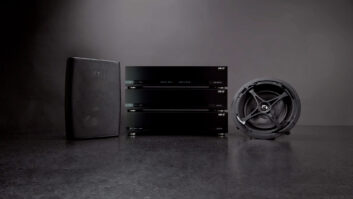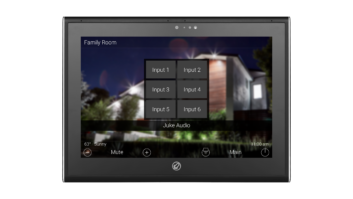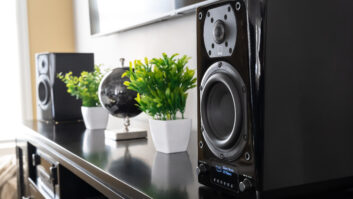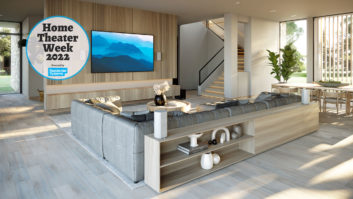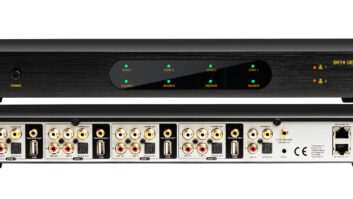
In addition to the dongles, the GoRave demo kit consists of two GoRave AR5 5-channel audio receivers, a pair of GoRave in-ceiling speakers, and an outdoor speaker. The company offers a broad range of its own speakers, including two sizes of outdoors, two different in-ceilings, four bookshelves, and an eight-inch sub, along with several wall plate connectors, volume controls, and mounting hardware. “These are the days of miracle and wonder,” Paul Simon once sang. “This is a long-distance call,” he added, to punctuate the point. That was 1986, mind you, when the long-distance call wasn’t exactly a miracle of modern technology, although nowhere near as ubiquitous as it is today, and certainly more expensive. The point that Paul was trying to make in his song “The Boy in the Bubble” is that technology changes quickly, to the point where outright technological miracles are soon taken for granted.
You can reference my review of the new Autonomic MMS-2S Mirage Media Server from last month’s issue for more thoughts on just how much the musical landscape has changed in the past few years. But, of course, you don’t need for me to point out just how much the wireless revolution has changed the way people consume music. And I think it’s a safe bet to say that you’re not taking it for granted, either. AirPlay, Bluetooth, DLNA, and other streaming audio technologies have made the once-magical process of consuming music in multiple rooms throughout the home easier than ever (if not outright ubiquitous), and there are upsides and downsides to that. The upside? Usually more convenience for the consumer. The downside? Well, I’m going to guess that more than one or two of you have gone through the trouble of designing a feature-packed distributed audio system complete with servers and discrete architectural speakers sometime in the past few years, only to have the client ask, “Yeah, but, what about Sonos?”
And yes, I know that a good many of you have had quite a bit of success integrating Sonos into more advanced distributed audio systems. But I’m betting you’re still on a the lookout for a truly integrator-friendly distributed audio product that is designed from the ground up to bring custom-installed multi-zone audio into the wireless, digital, super-convenient-and-not-too-expensive modern digital music age.
Could that product be GoRave’s Wireless Multi-Room Audio System? To find out, I got the company’s demo kit in for review, which consists of a two-zone, in-ceiling/outdoor system complete with speakers, audio receivers, and a variety of “senders” designed for Android, iOS, and USB-equipped devices like laptops and such.
Wait, what? Senders? Yeah, perhaps I should back up and explain here that GoRave is based on the SKAA wireless audio technology employed by Korus, Nu Force, a handful of Monitor Audio products, and a few others. What sets SKAA apart is mainly the fact that it relies on dongles attached to your portable audio devices instead of utilizing internal antennae such as Bluetooth or WiFi. The upsides to SKAA are its virtual lack of latency, its excellent audio quality, and the fact that you don’t have to dig around in your portable audio device’s menus to start streaming audio to external devices. Plug the dongle in, and if an audio or video streaming app or even a game on your portable audio device makes noise, that noise will transmit through the GoRave system.
The downsides are… well, you now have to keep track of an itty bitty dongle, which you almost certainly won’t want to keep attached to your phone or tablet at all times.

The GoRave Lightning dongle is pretty small, and when you’re dealing with a system that can play in multiple rooms that could be an inconvenience. In addition to the dongles, the GoRave demo kit consists of two GoRave AR5 5-channel audio receivers ($934.46 each), a pair of GoRave in-ceiling speakers, and an outdoor speaker. The company offers a broad range of its own speakers, including two sizes of outdoors, two different in-ceilings, four bookshelves, and an eight-inch sub, along with several wall plate connectors, volume controls, and mounting hardware.
Each of the AR5s features a pretty flexible speaker output, which can support two stereo pairs and an additional blended/mono output (that can be used to support a subwoofer, should you so choose). The company also informed me that you could run 10 4-ohm speakers instead of five 8-ohm speakers, if that works better for your installation. All audio connectors are of the phoenix variety (even on the speaker end), which made setup super easy, although I didn’t actually mount the ceiling speakers in the ceiling. Still, it was enough to gauge the simplicity of configuration and the functionality and performance of the system overall.
One of the advantages that GoRave touts about its system is that it doesn’t require a special app to work. Any audio generated by your mobile devices is broadcast to the receivers via the connected dongle. And while that may be true for certain situations, if you’re using older iOS devices with 30-pin connections, or if you want to independently control the volume of separate zones, you’ll still need the GoRave app (which I found for free on the iTunes App Store). It’s simplicity incarnate, though, with volume sliders and a mute button for each zone in the house. All I had to do was connect the speakers to each receiver, plug them into power (you will need a three-prong mains outlet handy), fire up the app, and that was that. The system immediately recognized that I was running two zones, and gave me controls for each.
Audio quality was quite pleasing. The GoRave speakers might not win any awards with hardcore audiophiles, but the sound was nicely balanced and plenty loud, with no egregious problems worth mentioning. The sound was also impeccably timed with the onscreen action on my iPhone, which took music-related games like Groove Coaster to an entirely new level of enjoyability. And furthermore, the range proved to be excellent. I could stream to the outdoor system on my patio and the indoor system in my master bedroom from anywhere in the house.
If I have one complaint, it’s that the GoRave Lightning dongle is pretty small, and when you’re dealing with a system that can play in multiple rooms that could be an inconvenience. I found myself misplacing the dongle quite frequently; to be fair I’m getting to that age where if I set a flashlight or measuring tape down, I may as well just go buy another one. Some manufacturers of SKAA-based gear recommend setting up a dedicated player for use with the system (an iPod Touch, perhaps) and just leaving the dongle attached. GoRave recommends leaving the sender attached to the included charging cable. And both of these could be very workable solutions.
Otherwise, if you’re looking for an easy-to-install, integration-friendly distributed audio system that reflects the way most people are consuming personal entertainment these days, go with GoRave. The company sells both complete packages, as well as à la carte components. If you want to install the receivers and senders, but bring your own preferred architectural or outdoor speakers, it’s easy to mix and match.
780.391.3000
www.gorave.com
Kudos
GoRave is a flexible, customizable SKAA-based wireless muti-zone audio system that’s easy to install and easier to use, with great sound quality and no latency.
Concerns
Using the system does require that a tiny, easy-to-lose dongle be attached to your portable audio device.
Product Specs
• One 10-pin phoenix connector for speaker outputs (front left and right, rear left and right, plus one mono)
• One 5-pin phoenix connector for aux analog audio input
• One serial programming port
• Continuous Power Output: 25 watts per channel
• Frequency Response: 20 to 20 kHz
• Speaker Impedance: 4 to 16 ohms
• Power Requirements: 90- 270 VAC 50/60Hz
• Power Consumption Maximum: 160 watts
Micro Review: D-Link’s WiFi Dual-Band Range Extender
by Jeremy J. Glowacki

The D-Link DAP-1520 I work out of a home office and typically remain tethered to an Ethernet cable during the day. In the evening, however, my wife and I struggle to get our daughters to settle down for bed, so while I wait, nag, wait nag [repeat] I depend on my WiFi-connected iPhone video streaming capabilities to keep myself sane with a ballgame or fun Facebook post. Like most houses, there are pockets (particularly upstairs) where the WiFi drops to a single bar, rendering video streaming choppy at best. So, when I was offered the opportunity to review D-Link’s DAP-1520 Wi-Fi dual-band range extender, I jumped at the chance. After a slight panic upon learning that my 2Wire router WPS button didn’t work, I configured the extender via web browser and was pleasantly surprised at how simple the set-up wizard was to use. An extender only works as well as the signal that it’s extending, so plugging in the DAP-1520 in the proper location was an important step. I found a well-placed outlet near the base of my stairs and voila! I had extended internet access throughout the entire house and felt like an IT pro. Now my iPhone defaults to the WAP, but when the signal is weak, it switches automatically to the DAP-1520 and my sanity is momentarily restored.

